
Services 》Augmentation Rhinoplasty
Augmentation Rhinoplaty
by Dr. Lih-Ren Jong
Nose is located in the center of face. Nose plays an important role in facial aesthetic. In Asia country, augmentation rhinoplasty( surgery to heighten nose) is popular because nose of Asian people is relatively flat and board, comparing with Caucasian people. Face looks flat and wide in people with flat nose. After augmentation rhinoplasty, face looks narrower and more three-dimension. In simple words, more beautiful after surgery. If chin is retracted, chin augmentation can be performed at the same time as rhinoplasy. The facial profile improves after both surgery ( refer to below site http://www.lrclinic.com.tw nose anatomy Nose can be divided into radix, dorsum, tip and columella. In anatomy, nose is composed by nasal dorsum, upper lateral and lower lateral cartilage, just as demonstrated in below picture.

-
Traditional augmentation rhinoplasty (abbreviated as AR)
Traditional way of augmentation rhinoplasty is to insert silicone into nose. Silicone has been used in aesthetic surgery since about 1960. The material is stable and non-toxic and relatively cheaper. The original shape of silicone used in augmentation rhinoplasty is L-shape (below left picture). L-implant augment nose dorsum and tip. If tip is high enough, I-shape implant could be used to augment dorsum (below right picture). The operation is performed under local anesthesia. A small wound is made on one side of nostril. After dissection, the implant is inserted into nose.
(1)The columella part of L-implant lifted up the nose tip skin. The tip skin could become thinner through a period of time. The pointed implant on the tip (implant show) might be noted in appearance. In sever case, extrusion might occur.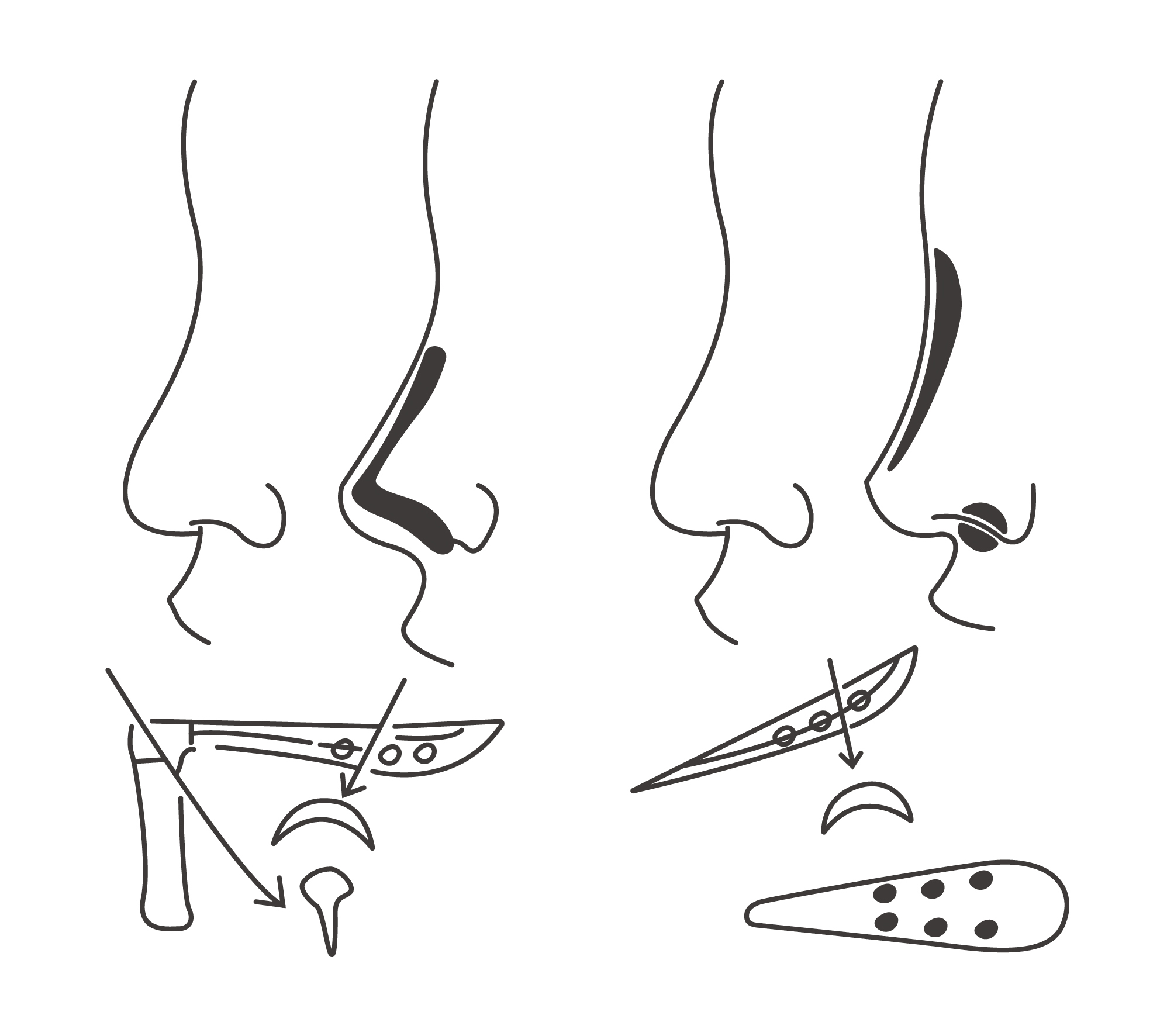
Below showed a case before AR (left picture) and 1.5 year after AR. L-implant was inserted.
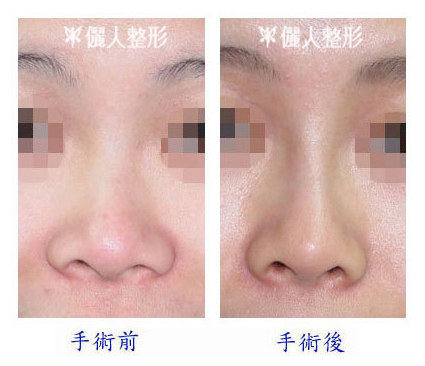
Below showed a case before (left) and after (right) I-shape implantation. The result is natural if using appropriate implant.

Although traditional way of AR is easier, but the possible side effects are:
(2)The implantation procedure is a rough and blind procedure. The postoperative tip point may be different with the natural tip point. This is one of reason of postoperative unnaturalness. Below showed a postoperative case performed by another surgeon. The length of implant is too long. The new tip (marked by yellow) was located in a position below natural tip point and too sharp.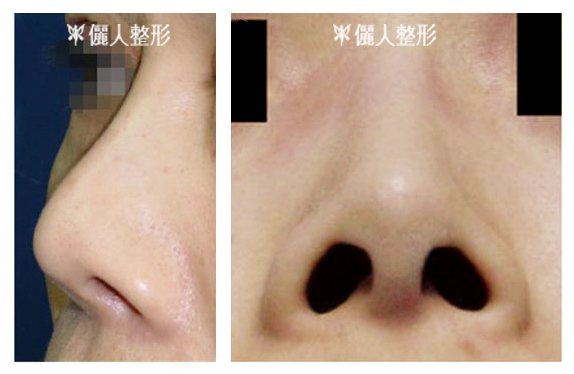
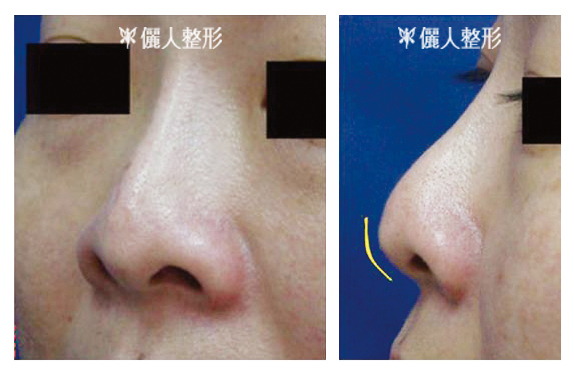
The implant of below case is too short. New tip (yellow arrow) is located above expected tip point (green arrow). In two-pierce rhinoplasty, described in next section, the inner structure of nose can be seen and reconstructed into new position. The result is more natural than traditional rhinoplasty.
(3)ContractureA thin capsule will be formed around the implanted silicone to separated foreign body (silicone) from human body. The capsule might get thicker or contracted due to overreaction of some people to silicone. In appearance, it is easy to identify the shape of implanted silicone, just as showed in below case.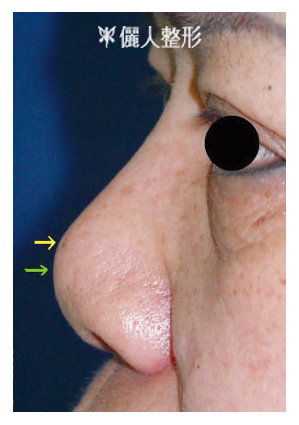
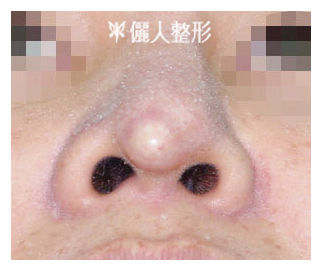
One of the way to improve pointed tip after L-shape silicone implant is to add a small pierce of ear cartilage on tip of silicone, just as showed below. In the case showed below,the tip of implant can be noticed after this modification.

-
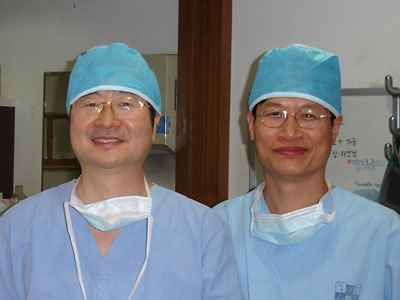
The concept of rhinoplasty has been presented in recent years. The concept is to eliminate the possible complications caused by traditional rhinoplasty, especially the problems on tip after surgery.
Open rhinoplasty. It means that rhinoplasty is performed under direct vision. There will be a wound which cross columella and connected with the wound inside the nostril.
It is included :
Lower lateral cartilage -key structure in tip- is reconstructed by suture or by strut which is taken from rib or septum or ear till the expected shape has been achieved. Implant, such as silicone, etc, is always needed to augment the deficient part on dorsum.
The concept of using implant on dorsum and cartilage on tip is named as two-pierce agumentation rhinoplasty in Taiwan.
Other kinds of materials, such as Gortex or Chimera, may to choose to augment dorsum. Below pictures showed the donor sites of cartilages. Left is location of septum (part of septal cartilage could be taken out). Middle marked the area which could be taken out from ear. Right is location of rib cartilage.
Below demonstration showed how the cartilages are used to form a new tip. Usually new tip is higher than before or tip is elongated to improve nostril show. Cartilage from septum or rib is used to support tip in new position.
Then cartilage from ear is used to refine the tip. All the procedure is done in direct vision.
Below showed a case after two-pierce AR. Right is picture taken on one year after surgery.
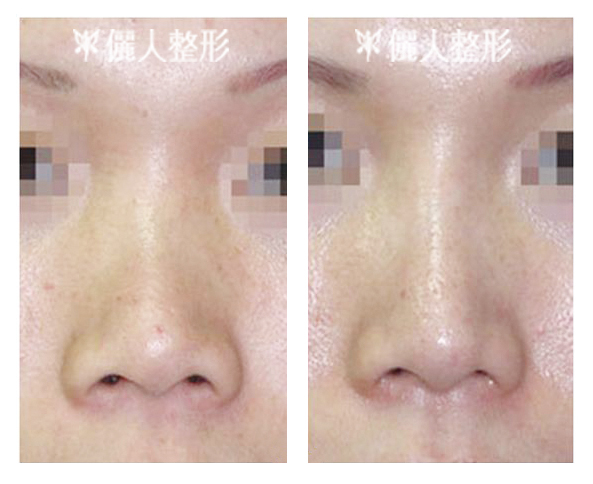
Below showed a case after two-pierce AR. Postoperatively (lower row) her tip is smooth and natural. Problem associated with L-implant (implant show on tip) did not occur on her.
A short scar on columella is quite unnoticed. She is satisfied with the result.


Below showed a case after tip plasty (tip was enlongated and more projected) with cartilage. Right picture is taken on 4 months after surgery. Tip looks quite natural.
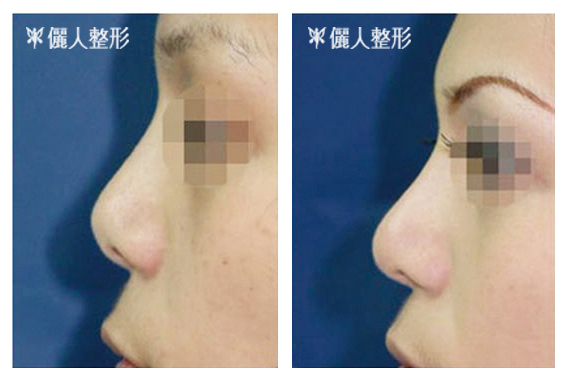 Below case hoped to correct her nostril show and lower dorsum. Left is before picture. Right is after picture. Using two-pierce rhinoplasty concept, tip was elongated to improve nostril show. Dorsum was augmented with silicone.
Below case hoped to correct her nostril show and lower dorsum. Left is before picture. Right is after picture. Using two-pierce rhinoplasty concept, tip was elongated to improve nostril show. Dorsum was augmented with silicone.
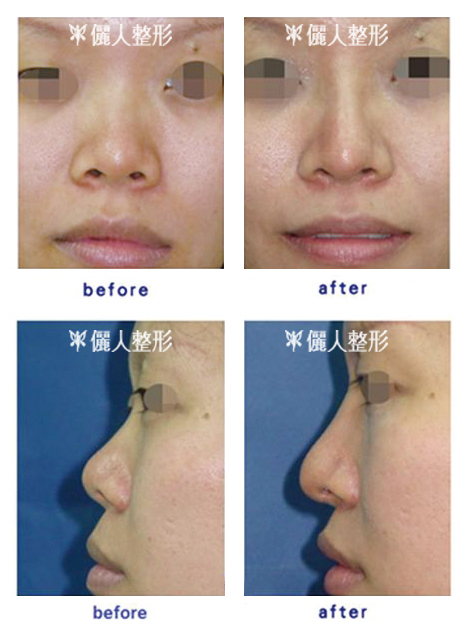 Below case showed the rsult after two-pierce agumentation rhinoplasty (right picture). People around her said she is more beautiful.
Below case showed the rsult after two-pierce agumentation rhinoplasty (right picture). People around her said she is more beautiful.
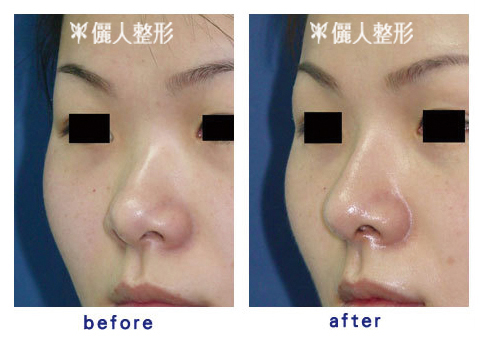 Below case underwent L-implant insertion for more than 10 years in another clinic. The tip was quite unnatural because of the projected silicone tip. Revision rhionoplasty was performed in my clinic.
Below case underwent L-implant insertion for more than 10 years in another clinic. The tip was quite unnatural because of the projected silicone tip. Revision rhionoplasty was performed in my clinic.
The silicone on tip was excised. New tip was reconstructed using septal and ear cartilages. After surgery, tip is round and natural.
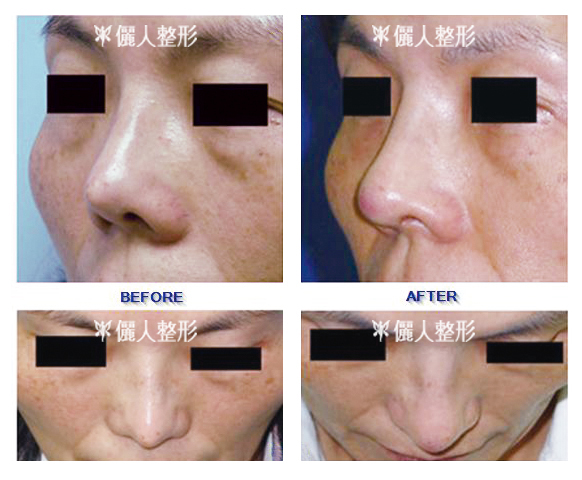
Below case underwent I-shape silicone implant to augment her dorsum before. Tip was not treated. Later she hoped her dorsum could be higher and bulbous tip could be higher and narrower.
She underwent two-pierce rhinoplasty. Dorsum gets higher and tip gets more projected. She is satisfied with the result.
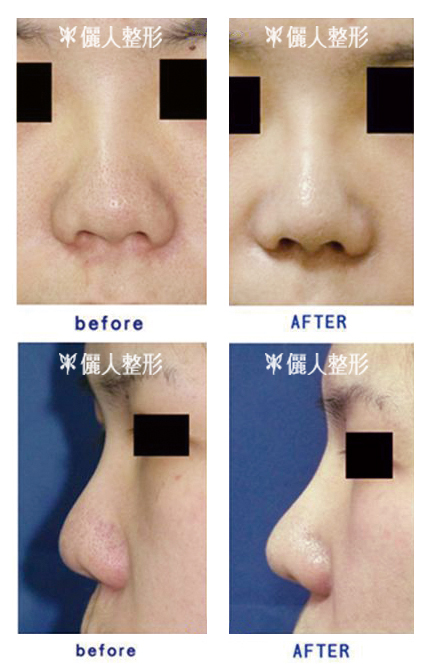
Below is a flat nose case. In first though (left picture), she only wanted to have her dorsum higher. She underwent augmentation rhinoplasty with I- shape implant (middle picture). The result was natural. A minor depression (arrow), which was the junction of implant with tip tissue, was noted. Later on, she though her tip could be higher and nostril show could be less.
She decided to undergo two-pierce rhinoplasty. Right picture showed the result after two-pierce rhinoplasty. If you want a natural higher nose, why should not choose to agument tip and dorsum with two-pierce rhinoplasty in first place?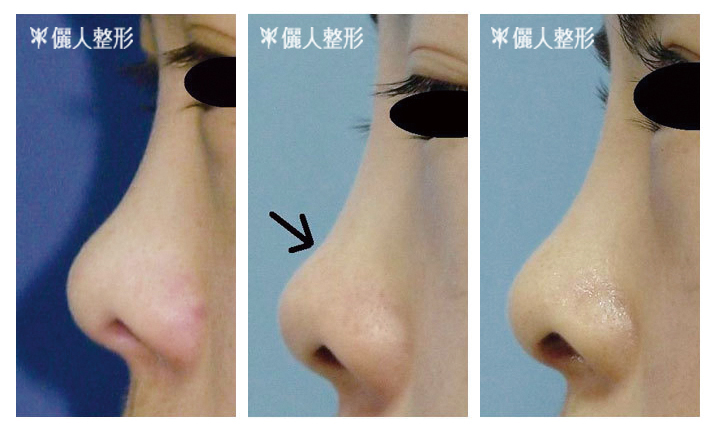
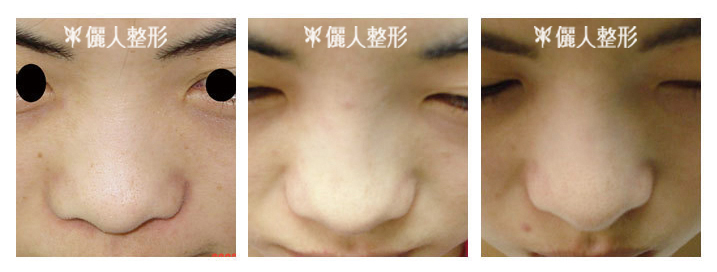
Below case underwent augmentation rhinoplasty with L-silicone implant. Pointed implant show (arrow) was noted on her tip. After revision with two-pierce rhinoplasty, her nose looks natural.

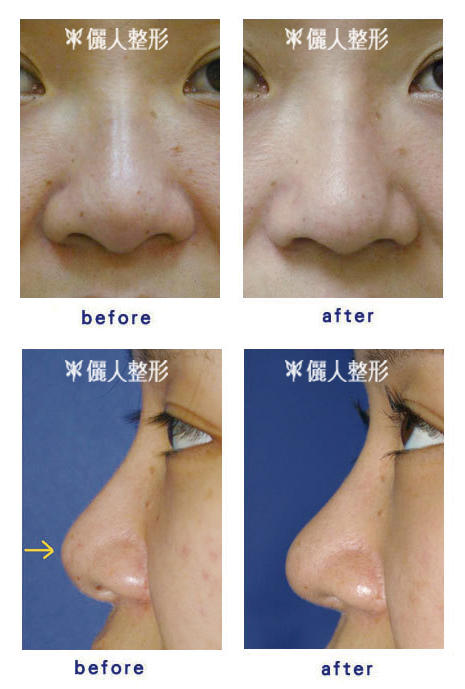 Below case underwent septal surgery to correct her deviated septum before. There is not enough septal cartilage to support her new tip. Rib cartilage was taken to support her new tip.
Below case underwent septal surgery to correct her deviated septum before. There is not enough septal cartilage to support her new tip. Rib cartilage was taken to support her new tip.
Right picture is the result after two-pierce rhinoplasty (implant on dorsum and rib and ear cartilage on her tip). Because size of rib cartilage is quite bigger than septal cartilage and the size of septal cartilage which can be taken to support tip is unpredictable, rib cartilge is a better choose to form a new tip in selected cases.
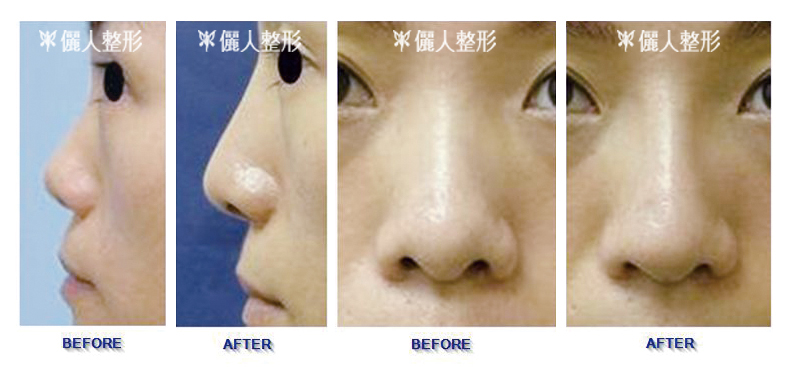
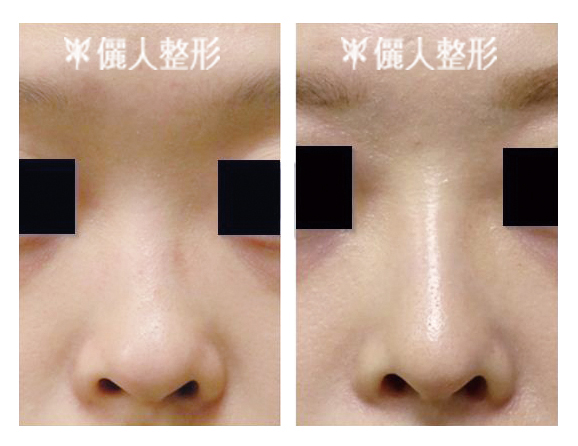
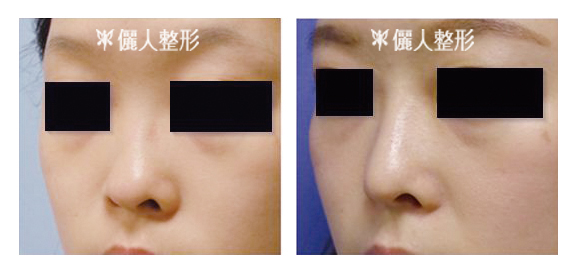
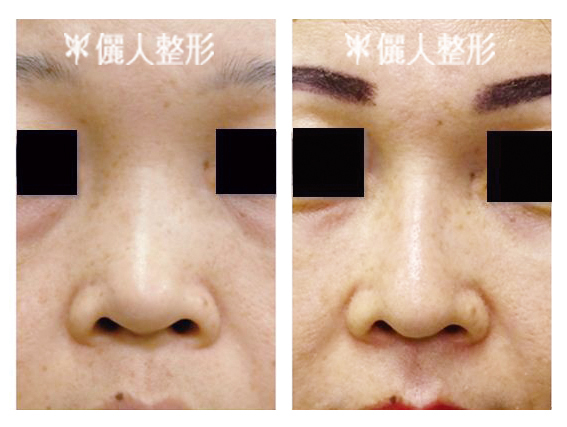
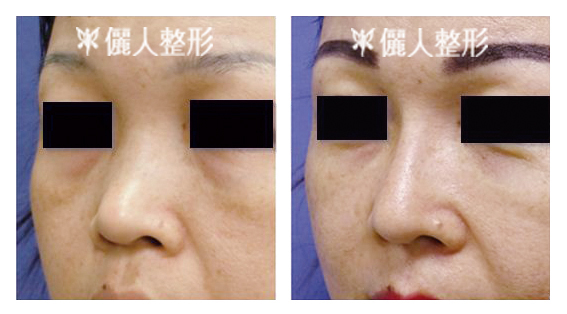
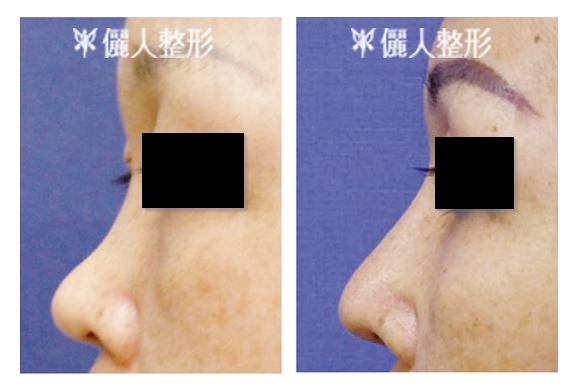
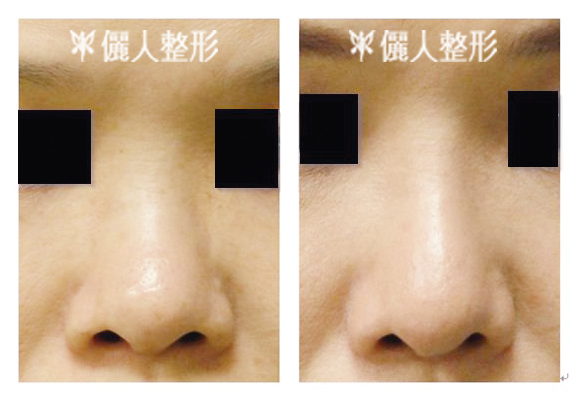
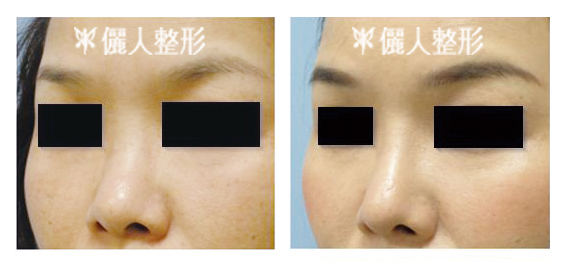
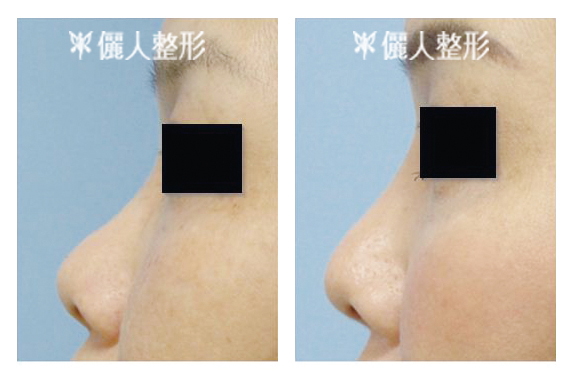
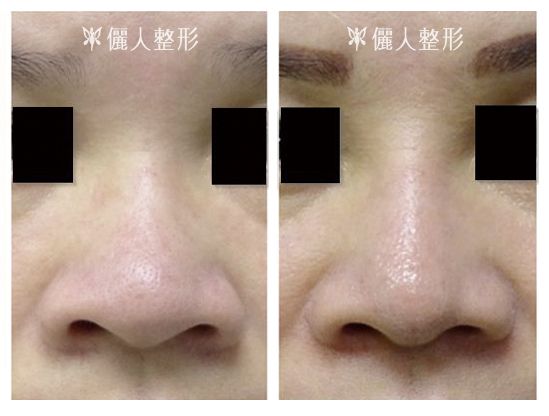
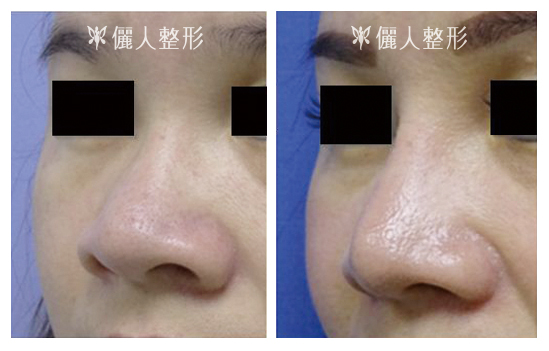
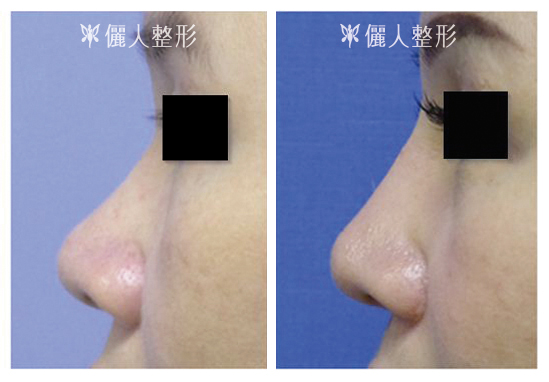
-
Tip plasty
High projected tip is more beautiful and natural than high dorsum without adequate tip projection. So that tip plasty is an important job in rhinoplasty. Tip of below case was not beautiful.
After tip plasty with septal and ear cartilages, she is happy with the result. No implant was used in the procedure.
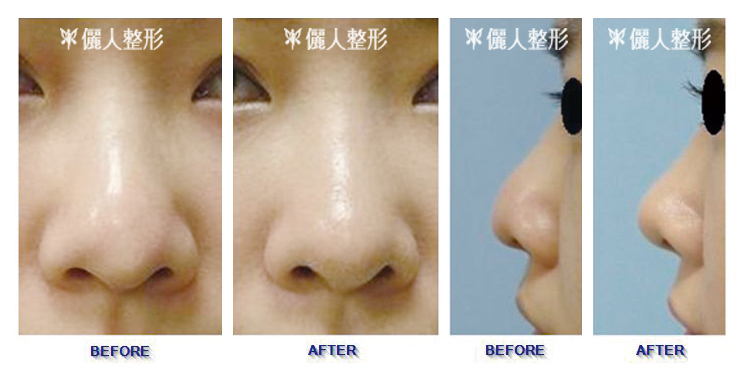
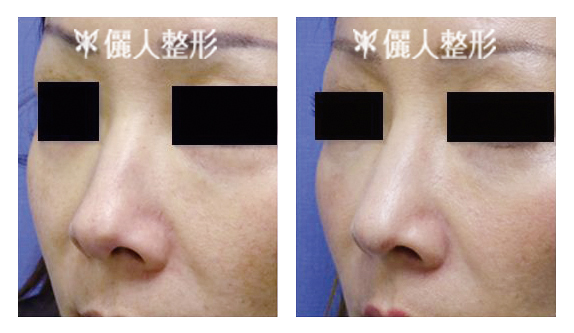
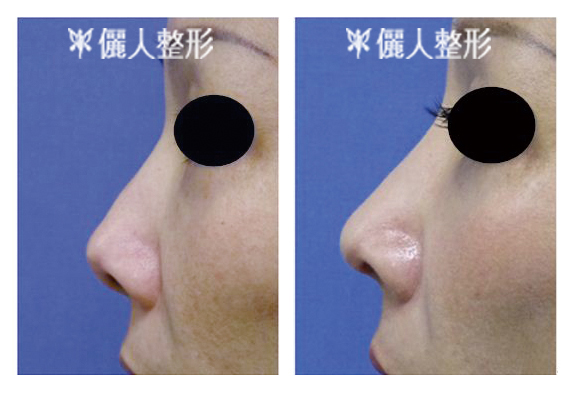 Below case showed the result of correcting drooping tip. The tip was supported with septal cartilage.
Below case showed the result of correcting drooping tip. The tip was supported with septal cartilage.
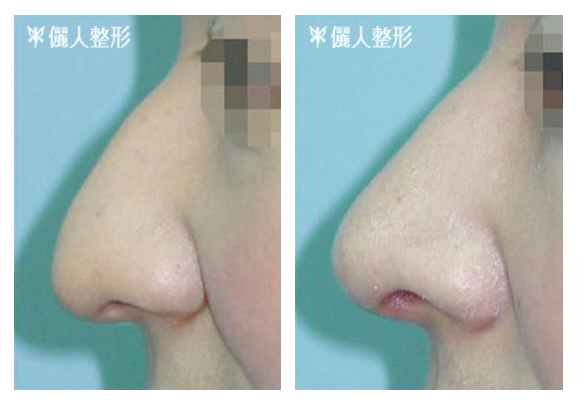
-
Material to augment dorsum
- The most common used material to augment dorsum is silicone. The material has been used for more than 4 decades, therefore physicians understand the material well.
The good sides of silicone are:♦ Stable.
♦ Non-toxic
♦ More inexpensive, etc.The negative sides of silicones are:
♦There would be capsule formed around silicone. Sometime the capsule may be contracted. The sequence of capsule contracture is that dorsum become too shape, so that other people may notice the implant which was under dorsal skin.♦The capsule may calcify in some spots, so that there will be some palpable hard lump (marked spot on below picture).♦Just as explained before. Silcone on tip might induce some problems.
- Cartilage
Just as explained in previous section, septal and ear cartilage are used to shape new tip.
The amount of above two cartilages is not enough to augment dorsum. Rib cartilage is large enough to augment dorsum, but the sequence of rib cartilage are scar on chest, more discomfort in recovery period and possible warping problems, etc. So that rib is used in special situation, such as revision surgery. - Gortex
Gortex has been used to augment dorsum for more than one decade. It is a stable substance. Occurrence of advert tissue reaction is quite low. Under microscope, there are a lot of pores in Gortex. Tissue can grow into holes of Gortex without forming capsule, therefore capsule contracture will not occur in Gortex. Original form of Gortex is a pierce with 3 mm thickness. In surgery, Gortex sheet can be cut and sewed several pierce together. Then sculpture into shape that is similar to silicone implant. It is custom-made implant. Below left shows the picture of Gortex sheet. Below right shows the custom-made Gortex.

In consultation, below case hoped her nose dorsum at a height which can not be achieved by silicone implant. In surgery, custom-made Gortex is sculptured and inserted into her dorsum. She is happy with the result.
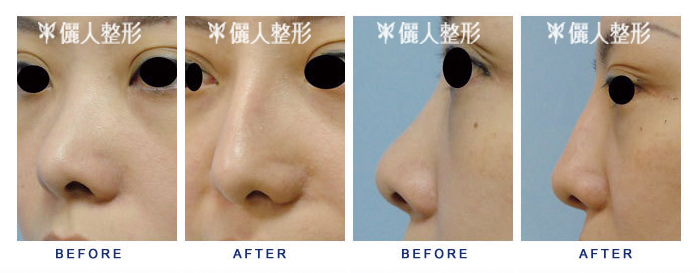
- Chimera
Chimera is a new material of augmentation rhinoplasty. It is silicone implant coating with thin layer of Gortex.
Below left is the appearance of Chimera. Right is the magnification view of the circle. The Gortex has been peeled to show the inner silicone core. One of the side effect of silicone implant is capsular contracture. Capsule is a membrane which surrounds the silicone. It is a natural tissue reaction to a foreign body. The capsule is usually thin, but in some patients the capsule is thick or it gradually becomes thicker and contracted. When capsular contracture occurs, the implant shape becomes noticeable in appearance. Below left was the picture taken on two months after surgery. Below right was the appearance on 5 years afte surgery. The implant shape became noticeable due to capsular contracture.
One of the side effect of silicone implant is capsular contracture. Capsule is a membrane which surrounds the silicone. It is a natural tissue reaction to a foreign body. The capsule is usually thin, but in some patients the capsule is thick or it gradually becomes thicker and contracted. When capsular contracture occurs, the implant shape becomes noticeable in appearance. Below left was the picture taken on two months after surgery. Below right was the appearance on 5 years afte surgery. The implant shape became noticeable due to capsular contracture.
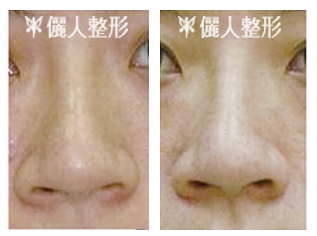 Capsular contracture is a term usually used on breast augmentation. When it occurs, the breasts become hard. In appearance, breasts look like two balls. Tissue can grow into the micropores of Gortex which is coated on silicone implant. No capsule is formed on Chimera implants. So that chance of capsule contracture is lower than conventional silicone implant.
Capsular contracture is a term usually used on breast augmentation. When it occurs, the breasts become hard. In appearance, breasts look like two balls. Tissue can grow into the micropores of Gortex which is coated on silicone implant. No capsule is formed on Chimera implants. So that chance of capsule contracture is lower than conventional silicone implant.- Filler (Hyaluroic acid or Radiesse)
For woman who is not sure that higher nose is suitable for her or she has not prepared for surgery, filler injection is another option. Recovery is quick after filler injection. But only minimal amount of filler can be injected into tip, so that effect on tip is minimal. You can not expect to have dramatic effect to improve nostril show with filler. Below showed a case after hyaluroic acid injection on dorsum.

Too much filler injection on tip makes tip broader, in stead of higher or narrowed. Rhinoplasty is the only way to correct bullbous nose or nostril show.
Below case had several times of filler injection, but she is not satisfied with the result of filler injection. After two-pierce rhinoplasty, she is happy with the result.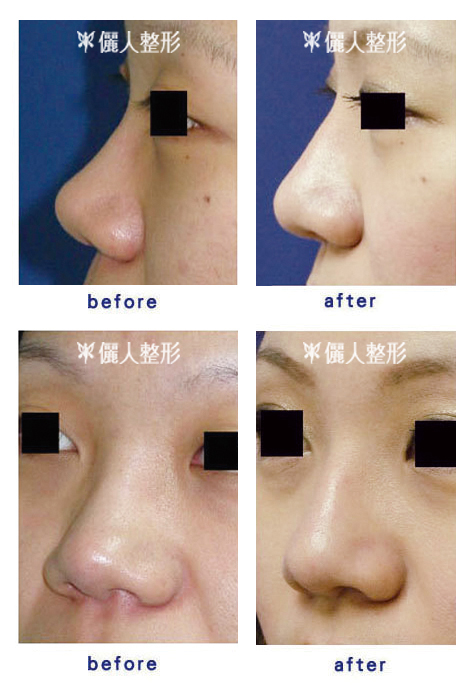
-
Other rhinoplasty
Reduce nasal bone base with bone surgery
The other two common rhinoplaty is hump removal and reduce width of nose dorsum.
Ideally, the width of nasal bone should be less than 80 % of nasal ala (please refer to below left picture). If nasal bone is too width, bone surgery to reduce its width is indicated (please refer to below right picture).

Below is before (left ) and after (right) pictures of reducing nasal bone width on six months after surgery. Blue lines marked the width of nasla bone.
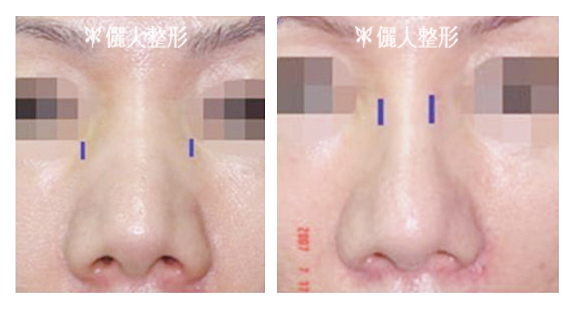
Reducing nasal bone width can be performed at the same time as augmentation rhinoplasty. Below case showed the result after (1) reducing bone width, (2) augmenting dorsum with Gortex, (3) tip plasty with sepal and ear cartilages.

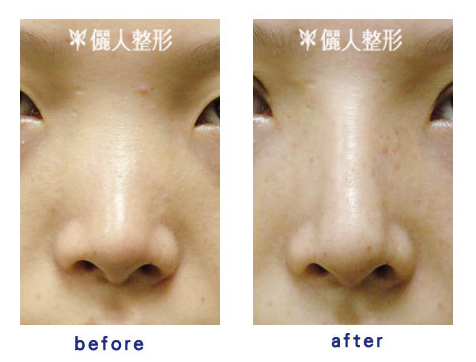
Hump removal
Hump included bony part and cartilagous part. Hump can be removed as the picture showed below.
Below case showed the result of hump removal and tip plasty. No implant was inserted.
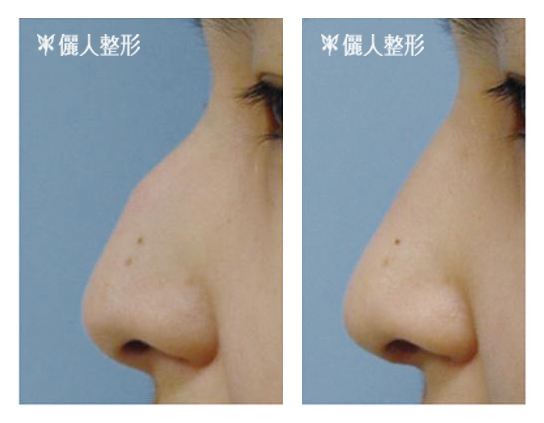
The other option of hump treatment is to trim the silicone implant on convex part of hump (without hump removal), so that the postoperative dorsum profile is smooth. Right picture showed the result of silicone implant augmentation on a case with hump.
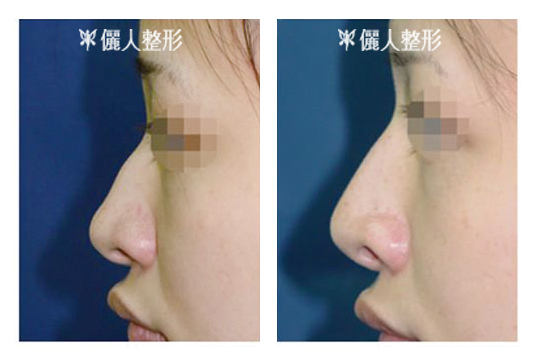
-
Alar surgery
- Alar reduction
Ideally, the alar width do not extend out of the vertical lines, drawing from the medial ends of eyes (demonstrated in the left picture). Below right showed one of ways of alar reduction.
Left ala showed the marking. Right ala showed the result after alar reduction. The scar is inconspicuous .
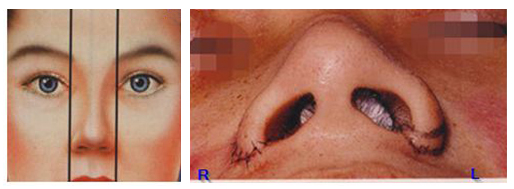
Below right showed the result of two-pierce augmentation rhinoplasty and alar reduction on 1.5 years after surgery.
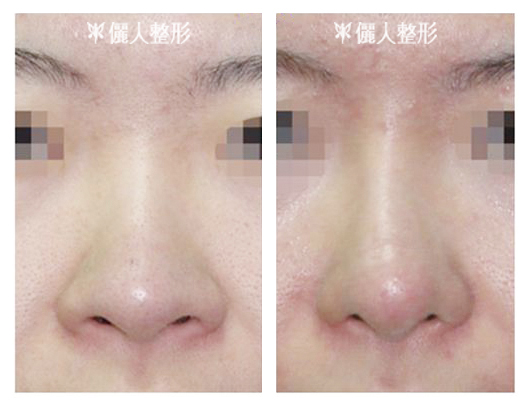
- Alar lowering
One of the ways of improving nostril show is alar lowering.
The arrows pointed to the concavity of alae which were improved by alar lowering procedure. The nostril show improved after surgery.
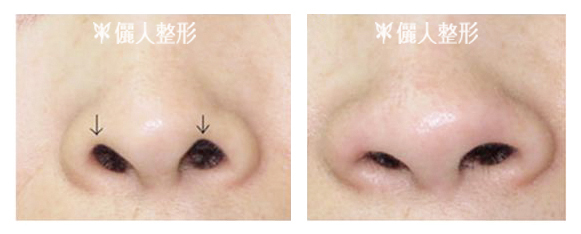
- Alar reduction
If you live abroad, you may send your questions and pictures (such as eyes, etc) to mail@LRclinic.com.tw .
We will reply you as soon as possible.









